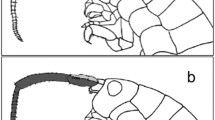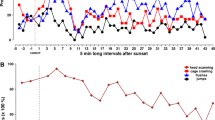Summary
The diurnal escape response of fringetoed lizards (Uma notata) startled by predators demonstrates clear directional orientation not likely to depend on local landmarks in the shifting sands of their desert environment. Evidence that celestial orientation is involved in this behavior has been sought in the present experiments by testing the effects of (1) phase shifting the animal's internal clock by 6 h and (2) by training the lizards to seek shelter while exposed to natural polarization patterns. In the first case, 90° shifts in escape direction were demonstrated in outdoor tests, as expected if a time-compensated sun or sky polarized light compass is involved. In the second instance, significant bimodale-vector dependent orientation was found under an overhead polarizing light filter but this was only evident when the response data were transposed to match the zenithe-vector rotation dependent on the sun's apparent movement through the sky. This extends to reptiles the capacity to utilize overheade-vector directions as a time-compensated sky compass. The sensory site of this discrimination and the relative roles of sun and sky polarization in nature remain to be discovered.
Similar content being viewed by others
References
Adler K (1976) Extraocular photoreception in amphibians. Photochem Photobiol 23:275–298
Adler K, Taylor DH (1973) Extraocular perception of polarized light by orienting salamanders. J Comp Physiol 87:203–212
Aneshansley DJ, Larkin TS (1981) V-test is not a statistical test of ‘homeward’ direction. Nature 293:239 (including response by R Baker and J Mather)
Batschelet E (1981) Circular statistics in biology. Academic Press, London
Brines M (1980) Dynamic patterns of skylight polarization as clock and compass. J Theor Biol 86:507–512
Cowles RB, Bogert CM (1944) A preliminary study of the thermal requirements of desert reptiles. Bull Am Mus Nat Hist 83:261–296
DeRosa CT, Taylor DH (1982) A comparison of compass orientation mechanisms in three turtles (Trionyx spinifer, Chrysemys picta andTerrapene Carolina). Copeia 1982:394–399
Eakin RM (1973) The third eye. University of California Press, Berkeley Los Angeles
Fischer K (1961) Untersuchungen zur Sonnen-Kompassorientierung und Laufaktivität von Smaragdeidechsen (Lacerta viridis Laur.) Z Tierpsychol 18:450–470
Fischer K, Birukow G (1960) Dressur von Smaragdeidechsen auf Kompassrichtungen. Naturwissenschaften 47:93–94
Frisch K von (1967) The dance language and orientation of bees. Belknap Press, Cambridge, Massachusetts
Gloyd HK (1937) A herpetological consideration of faunal areas in southern Arizona. Bull Chicago Acad Sci 5:79–136
Hamasaki DI, Eder DJ (1977) Adaptive radiation of the pineal system. In: Crescitelli F (ed) The visual system in vertebrates (Handbook of sensory physiology, vol VII/5). Springer, Berlin Heidelberg New York, pp 497–548
Jander R, Waterman TH (1960) Sensory discrimination between polarized light and light intensity patterns by arthropods. J Comp Physiol 56:137–160
Murphy PA (1981) Celestial compass orientation in juvenile American alligators (Alligator mississippiensis). Copeia 1981:638–645
Sekera Z (1957) Polarization of skylight. In: Flügge S (ed) Geophysik II. (Handbuch der Physik, vol. 48). Springer Berlin Heidelberg New York, pp 288–328
Stebbins RC (1944) Some aspects of the ecology of the iguanid genusUma. Ecol Monogr 14:311–332
Taylor DH, Adler K (1978) The pineal body: site of extraocular perception of celestial cues for orientation in the tiger salamander (Ambystoma tigrinum). J Comp Physiol 124:357–361
Taylor DH, Auburn JS (1978) Orientation of amphibians by linearly polarized light. In: Schmidt-Koenig K, Keeton WT (eds) Animal migration, navigation and homing. Springer, Berlin Heidelberg New York, pp 334–346
Underwood H (1973) Retinal and extraretinal photoreceptors mediate entrainment of the circadian locomotor rhythm in lizards. J Comp Physiol 83:187–222
Underwood H, Menaker M (1970) Extraretinal light perception: entrainment of the biological clock controlling lizard locomotor activity. Science 170:190–193
Waterman TH (1981) Polarization sensitivity. In: Autrum H (ed) Comparative physiology and evolution of vision in invertebrates (Handbook of sensory physiology, vol VII/6B). Springer, Berlin Heidelberg New York, pp 281–469
Waterman TH, Aoki K (1974)E-vector sensitivity patterns in the goldfish optic tectum. J Comp Physiol 95:13–27
Waterman TH, Hashimoto H (1974)E-vector discrimination by the goldfish optic tectum. J Comp Physiol 95:1–12
Wehner R (1976) Polarized light navigation by insects. Sci Am 235:106–115
Wehner R, Duelli P (1971) The spatial orientation of desert ants,Cataglyphis bicolor, before and after sunrise. Experientia 27:1364–1366
Wehner R, Menzel R (1969) Homing in the antCataglyphis bicolor. Science 164:192–194
Author information
Authors and Affiliations
Rights and permissions
About this article
Cite this article
Adler, K., Phillips, J.B. Orientation in a desert lizard (Uma notata): time-compensated compass movement and polarotaxis. J. Comp. Physiol. 156, 547–552 (1985). https://doi.org/10.1007/BF00613978
Accepted:
Issue Date:
DOI: https://doi.org/10.1007/BF00613978




